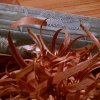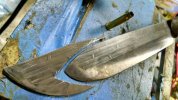- Joined
- Apr 12, 2014
- Messages
- 801
I was looking for some help with an idea that I had. The idea is to convert a old Case XX butcher knife into a Kephart/Spear point. My problem is I know how to handle a cutting wheel and a grinder, but know next to nothing about temper, heat treat, and how/if this can be done without destroying the integrity of the steel.
Is it possible to remove that much material without having to re-heat treat the blade when done?
When talking temper and heat treat don't be afraid to keep it at a 3rd grade level........because I know nothing.

Is it possible to remove that much material without having to re-heat treat the blade when done?
When talking temper and heat treat don't be afraid to keep it at a 3rd grade level........because I know nothing.




